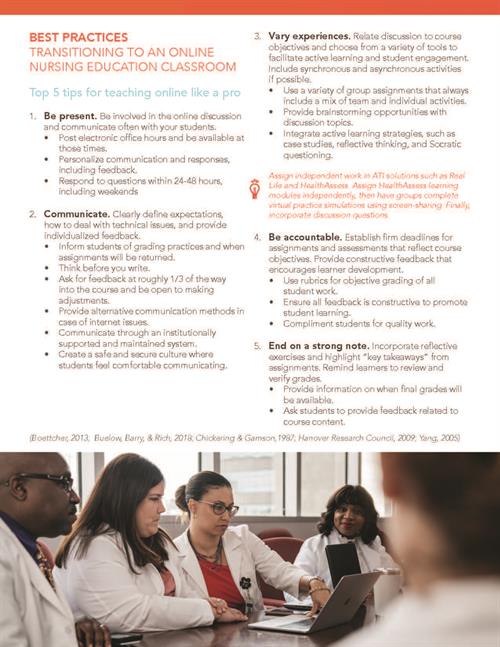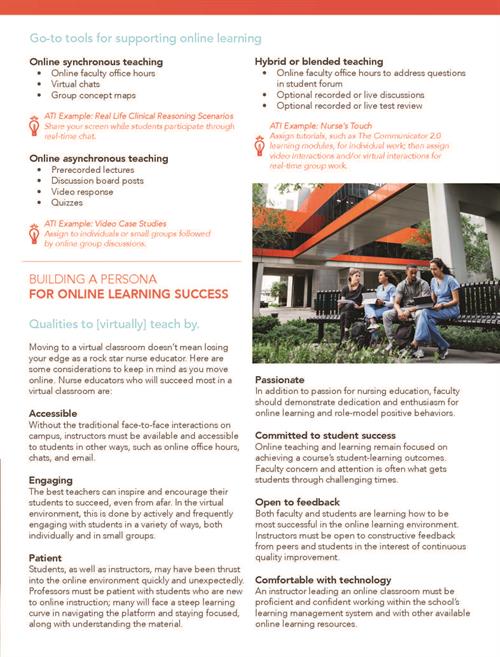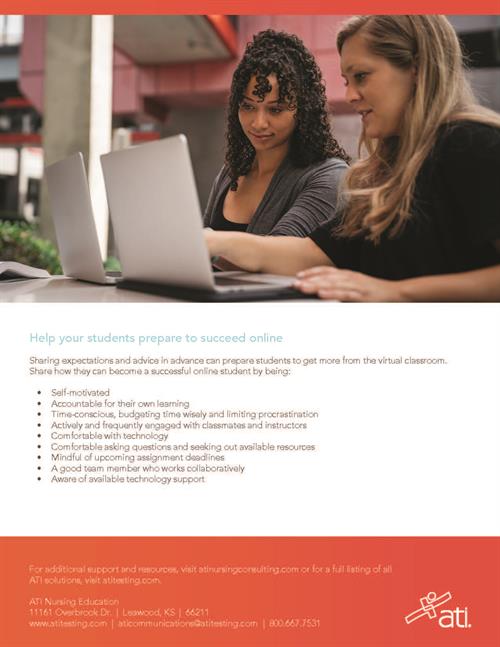NURSE EDUCATOR HANDBOOK: TRANSITIONING TO THE VIRTUAL CLASSROOM
DOWNLOAD THE HANDBOOK TO SHARE
 GETTING STARTED WITH THE BASICS
GETTING STARTED WITH THE BASICS
Defining 3 online teaching methods
Online asynchronous
- Faculty-monitored discussion boards
- Live discussions only as issues arise.
Online synchronous
- Scheduled (required) time to meet as a class
- Webcam or live discussion boards for faculty and students.
Hybrid or blended
- Recorded live video & chat sessions
- Online faculty office hours
- Optional live sessions.
Set up your online class for success
□ Post a welcome message.□ Open a forum for students to ask general questions throughout the course.
□ Ensure your syllabus includes the current book and resources.
□ Confirm your current syllabus is posted to the online classroom.
□ Include instructor contact information in your learning management system.
□ Share/post virtual office hours following school policies.
□ Select online learning tools, modules, and activities that directly map to course objectives.
TIP: Consider your ATI online learning solutions such as Pharmacology Made Easy, Dosage Calculation tutorials, NurseLogic, HealthAssess, Real Life, Nurse’s Touch, Civility Mentor, Skills Modules, and much more. Review ATI’s Educator Implementation Guides (EIGs) – in your ATI faculty portal under resources – for lesson objectives.
□ Include the start and end date for each learning module.
□ Check that links to learning modules readings, activities, movies, etc., are active.
□ Ensure assigned online tests are designed to assess course objectives.
TIP: ATI quizzing and testing solutions like Learning System 3.0, Content Mastery Series, or even tutorials with built-in quizzing like the Nurse’s Touch suite make great ready-to-use solutions. Plus, your EIGs can help you align each to course objectives. □ Review grade book to ensure all assignments are listed with correct point allocation. □ Develop discussion board topics for online learning activities. □ Ensure due dates for assignments are inserted in the learning modules.
 BEST PRACTICES TRANSITIONING TO AN ONLINE NURSING EDUCATION CLASSROOM
BEST PRACTICES TRANSITIONING TO AN ONLINE NURSING EDUCATION CLASSROOM
Top 5 tips for teaching online like a pro
1. Be present. Be involved in the online discussion and communicate often with your students.
- Post electronic office hours and be available at those times.
- Personalize communication and responses, including feedback.
- Respond to questions within 24-48 hours, including weekends
2. Communicate. Clearly define expectations, how to deal with technical issues, and provide individualized feedback.
- Inform students of grading practices and when assignments will be returned.
- Think before you write.
- Ask for feedback at roughly 1/3 of the way into the course and be open to making
adjustments. - Provide alternative communication methods in case of internet issues.
- Communicate through an institutionally supported and maintained system.
- Create a safe and secure culture where students feel comfortable communicating.
3. Vary experiences. Relate discussion to course objectives and choose from a variety of tools to facilitate active learning and student engagement. Include synchronous and asynchronous activities if possible.
- Use a variety of group assignments that always include a mix of team and individual activities.
- Provide brainstorming opportunities with discussion topics.
- Integrate active learning strategies, such as case studies, reflective thinking, and Socratic questioning.
TIP: Assign independent work in ATI solutions such as Real Life and HealthAssess. Assign HealthAssess learning modules independently, then have groups complete virtual practice simulations using screen-sharing. Finally, incorporate discussion questions.
4. Be accountable. Establish firm deadlines for assignments and assessments that reflect course objectives. Provide constructive feedback that encourages learner development.
- Use rubrics for objective grading of all student work.
- Ensure all feedback is constructive to promote student learning.
- Compliment students for quality work.
5. End on a strong note. Incorporate reflective exercises and highlight “key takeaways” from assignments. Remind learners to review and verify grades.
- Provide information on when final grades will be available.
- Ask students to provide feedback related to course content.
(Boettcher, 2013; Buelow, Barry, & Rich, 2018; Chickering & Gamson,1987; Hanover Research Council, 2009; Yang, 2005)
 Go-to tools for supporting online learning
Go-to tools for supporting online learning
Online synchronous teaching
- Online faculty office hours
- Virtual chats
- Group concept maps
TIP: ATI Example - Real Life Clinical Reasoning Scenarios
Share your screen while students participate through real-time chat.
Online asynchronous teaching
- Prerecorded lectures
- Discussion board posts
- Video response
- Quizzes
TIP: ATI Example - Video Case Studies
Assign to individuals or small groups followed by online group discussions.
Hybrid or blended teaching
- Online faculty office hours to address questions in student forum
- Optional recorded or live discussions
- Optional recorded or live test review
TIP: ATI Example - Nurse’s Touch
Assign tutorials, such as The Communicator 2.0 learning modules, for individual work; then assign video interactions and/or virtual interactions for real-time group work.
BUILDING A PERSONA FOR ONLINE LEARNING SUCCESS
Qualities to [virtually] teach by.
Moving to a virtual classroom doesn’t mean losing your edge as a rock star nurse educator. Here are some considerations to keep in mind as you move online. Nurse educators who will succeed most in a virtual classroom are:
Accessible
Without the traditional face-to-face interactions on campus, instructors must be available and accessible to students in other ways, such as online office hours, chats, and email.
Engaging
The best teachers can inspire and encourage their students to succeed, even from afar. In the virtual environment, this is done by actively and frequently engaging with students in a variety of ways, both individually and in small groups.
Patient
Students, as well as instructors, may have been thrust into the online environment quickly and unexpectedly. Professors must be patient with students who are new
to online instruction; many will face a steep learning curve in navigating the platform and staying focused, along with understanding the material.
Passionate
In addition to passion for nursing education, faculty should demonstrate dedication and enthusiasm for online learning and role-model positive behaviors.
Committed to student success
Online teaching and learning remain focused on achieving a course’s student-learning outcomes. Faculty concern and attention is often what gets students through challenging times.
Open to feedback
Both faculty and students are learning how to be most successful in the online learning environment. Instructors must be open to constructive feedback from peers and students in the interest of continuous quality improvement.
Comfortable with technology
An instructor leading an online classroom must be proficient and confident working within the school’s learning management system and with other available
online learning resources.
 Help your students prepare to succeed online
Help your students prepare to succeed online
Sharing expectations and advice in advance can prepare students to get more from the virtual classroom. Share how they can become a successful online student by being:
- Self-motivated
- Accountable for their own learning
- Time-conscious, budgeting time wisely and limiting procrastination
- Actively and frequently engaged with classmates and instructors
- Comfortable with technology
- Comfortable asking questions and seeking out available resources
- Mindful of upcoming assignment deadlines
- A good team member who works collaboratively
- Aware of available technology support
For additional support and resources, visit atinursingconsulting.com or for a full listing of all ATI solutions, visit atitesting.com.
